Day five of the Isle of Man Grand Swiss saw World No 2 Fabiano Caruana barely avoiding a loss at the hands of the Englishman Luke McShane in a spectacular game which lasted for over six and a half hours. On the second board, China’s Wang Hao split a point with the Junior World Champion Parham Maghsoodloo in a game full of twists and turns. On board 11, World Champion Magnus Carlsen scored a confident victory, getting back to the top pack. Candidate hopeful Alexander Grischuk won against Ivan Cheparinov. Aronian and Nakamura drew their games while World No 8, Wesley So, scored his first victory of the tournament. After five rounds, seven players are sharing the first place, with four points each: Wang Hao, Caruana, McShane, Fedoseev, Grischuk, Shirov and Maghsoodloo
On board one, England’s Luke McShane was playing against Fabiano Caruana. The Englishman had a great start to the tournament, scoring three consecutive wins after a draw in the first round. On day five, it was Caruana’s turn to ‘do a Carlsen’ from round four, and pull off the impossible.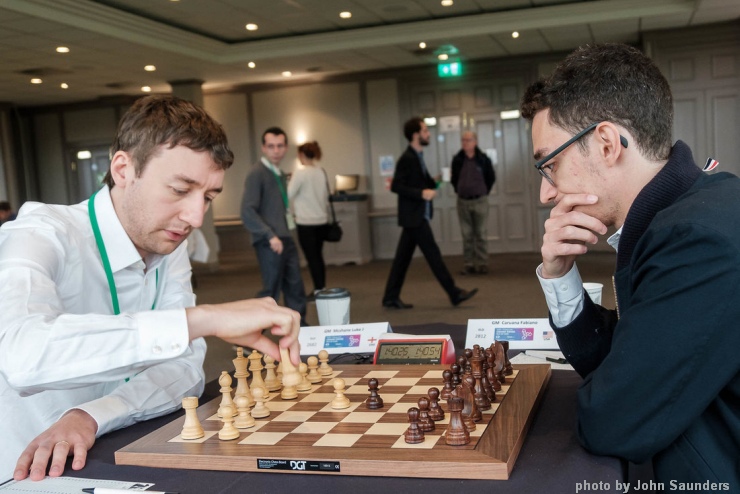
For the second game in a row, McShane played with white pieces. After Caruana weakened his king’s castle with h6, McShane moved his king to h1 (a novelty) and started preparing the advance of his g-pawn directly at the black king’s defence. Caruana quickly responded by throwing his c8-bishop into the game and including the queenside rook, launching a counter-attack. McShane had two knights (one of them back on d1) against two bishops. Caruana managed to create a slightly better position, with more time on the clock. After black’s imprecision on move 21 (according to the computer), Luke McShane launched his g-line attack, but also managed to secure an extra pawn along the way (which later grew to two pawn advantage), and activating his pieces. McShane was, however, lagging on time: he had just under eight minutes for 13 moves, while Caruana was on 30 minutes. The Englishman, however, pulled it off: by move 40, Caruana was in a considerably weaker position. McShane pushed 41.d6, which was an introduction to a dominating advantage in which his queen and knight were setting up a clean kill.
Then, an unbelievable thing happened: after the exchanges of pieces, the position unravelled into a rook vs bishop ending with White having a more active king. It still seemed like a clear victory for white, but the World No 2 put on an incredible defence and managed to prevent McShane from getting into a simple winning position. By move 74 – with the computer showing that White is winning – McShane was on three and a half minutes while Caruana had 10 minutes more. McShane then went for an exchange of pawns, but with black having an active g-pawn he was out of trouble. After six and hours and 40 minutes of play and 85 moves, the game ended in a draw.
Hao and Maghsoodloo draw in a game full of twists and turns
The game on board two, between China’s Wang Hao and the World Junior Champion, 19-year-old Parham Maghsoodloo, was full of turns. In the earlier stages of the game, Wang Hao sacrificed a pawn but pushed Black’s pieces to the back-lines. However, this situation should have been approached with caution: in many of Maghsoodloo’s games, he plays a lot from the back-ranks ready to counterattack. One thing played into the hands of the Iranian – he was consistently better on time. The game took an interesting turn in move 23 when, instead of accepting an exchange of queens, Wang Hao sacrificed an exchange to exploit black’s weak squares around his king. Maghsoodloo broke out with a brave march of his f-pawn and in a tense fight between time, tactics and material, the Iranian seemed to have managed to erase the compensational advantage the Chinese player had for his sacrifice.
What followed was a dynamic tussle between a marvellous attacker (Hao) and an excellent defender (Maghsoodloo). At one point Maghsoodloo blundered – on move 45 he moved his king to g7, exposing the black monarch to a lethal check. Then, however, Hao returned the favour and missed an opportunity. After several turns and chances being on both sides, the game ended in a draw.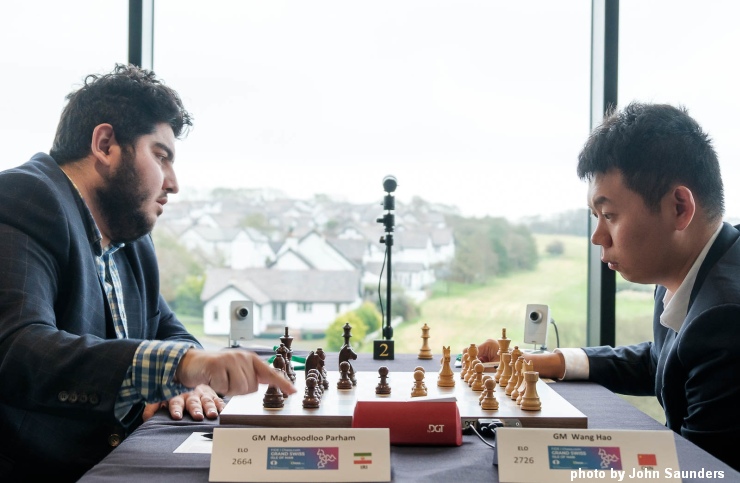
Grischuk, Fedoseev and Shirov push forward
Boards three to ten were reserved for 14 players who, after four rounds, had three points each.
Former contender for the title of World Champion, Sergey Karjakin played as black against David Anton Guijarro of Spain. In the neo-Catalan accepted variant of the English opening, White managed to push his pawn to e5, pinning the centre and pressing Black. The position was playable, but the Spaniard offered a draw which was accepted. Both players are on 3.5 out of five which still gives them solid chances.
Alexander Grischuk is one of the players hoping to secure a spot at the Candidates’. He achieved a slightly better position as white against Ivan Cheparinov on board three but was constantly behind on time. The opening led to a King’s Indian reverse, where black was two tempi down. By move 20, Cheparinov had weak pawns on a7 and c5. Grischuk went on to win the pawn on h6 and then transformed the game to a rook endgame where he was significantly stronger and forced Cheparinov to capitulate. Grischuk is now on four points.
Vladimir Fedoseev last year’s Isle of Man winner, Radoslaw Wojtaszek played a sharp line in Nimzo-Indian. It looked like White was in danger as Fedoseev’s king got stuck in the center while Black seemed much better developed. However, other positional factors proved to be much more important. Gradually it became clear that Russian GM was outplaying his dangerous opponent. Wojtaczek tried to complicate the issue by sacrificing two pawns, but Fedoseev seemed unfazed and took every pawn and piece that was offered to him. Polish GM resigned on move 47 allowing Fedoseev to catch up with the leaders.
On board five, Levon Aronian (who made a statement with his red shirt and red shoes) squared off against Ukrainian GM Yuriy Kryvoruchko. Aronian played one of his favourites, the Marshal Gambit, and the game saw a novelty by white: 20.a5. After the exchange of queens in the centre of the board, Black was left with an isolated pawn on d5. The game quickly progressed to an opposite-coloured bishops endgame where Aronian’s isolated pawn fell, but it was still a draw. The two quickly agreed to split a point.
The outcome of this game should be looked on in the light of the fact that this tournament is likely to be the last chance for the 37-year-old Levon Aronian to make it to the Candidates and have one more (final?) opportunity to get in the seat to challenge the World Champion for the title.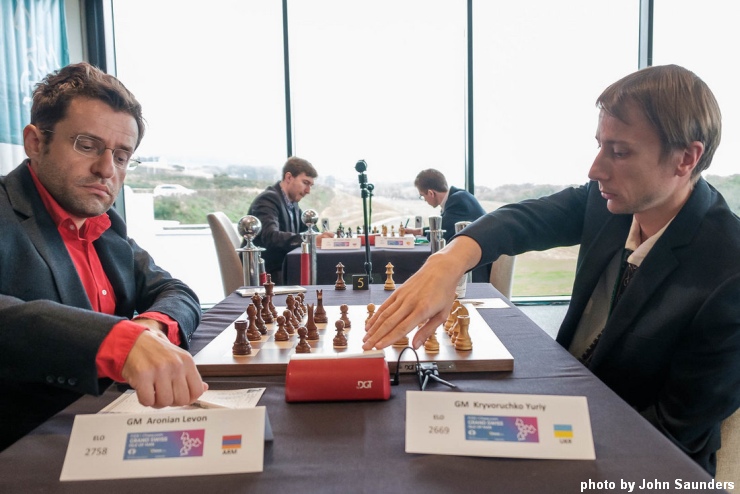
One of the other popular players, Hikaru Nakamura, had a quick draw in the Catalan against the Greek Olympic team member Ioannis Papaioannou by repetition as early as by move 17! A draw with Black isn’t a disaster for Hikaru Nakamura, but it suggests he is running out of time if he wants to compete for the top spot. If he continues this way, Nakamura is in danger of going out of the top-25 in the November rating list.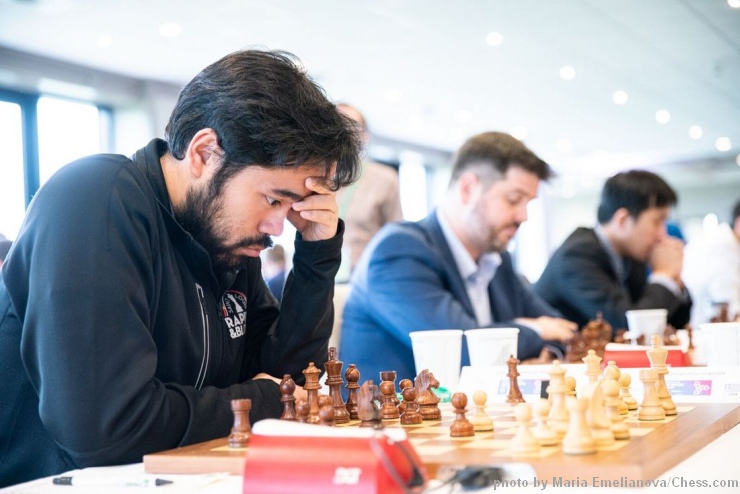
Alexei Shirov was confident against Gabriel Sargissian of Armenia. With four out of five, Shirov has bounced back to the top pack and is one to look out for.
Carlsen back in the chasing pack
Playing on board 11, the World Champion Magnus Carlsen was facing Surya Shekhar Ganguly of India. Until this encounter, Carlsen’s only classical game vs Ganguly was his win in Dubai in 2004, which helped the Norwegian secure his GM title (he just needed a draw from one more game). Magnus started with a sharp attack on the Najdorf, but in a variation which is theoretically not completely clear, leaving him space to improvise. As the World Champion pushed his pawns on both the kingside and the queenside, Ganguly decided to keep his king in the centre, assuming that he was most secure there. By move 16, however, Carlsen’s knight was on d5, dominating the centre and pivoting his initiative on both the kingside and the queenside front. The Indian tried to break loose from Carlsen’s grip but his task seemed impossible to achieve. For once in this tournament, the World Champion was the one dominating the other player by the middlegame.
Ganguly, however, isn’t Carlsen and was not favoured by the time-gods: the World Champion had both a good position and was good on time. There was no escape – the Indian resisted a bit more, but it was more a question of how the World Champion would win and not if. The two players later analysed their game outside the playing hall, where they both concluded that Bb7 with the idea of castling on the kingside might have offered more chances for black. In the later analysis for Chess.com, Carlsen said he would not generally recommend playing both a4 and g4 “as after that there is really no safe way to castle”.
A quick draw between master and apprentice
An interesting but brief game took place on board 26, between master and apprentice, GM Peter Leko and 14-year-old German IM Vincent Keymer, one of the top juniors at the event, who was playing as white. The two played 37 moves in about 40 minutes and in an even position with seven pawns and two knights each, they decided to draw. It was the first game of the day to finish. Keymer has two norms and is missing one more for a GM title. Whether this draw will help him and if this is the right way to achieve it, it remains to be seen. Another quick game to finish was that between compatriots Korobov and Kuzubov of Ukraine, who decided to share a point after 30 moves and an hour of play.
A ‘kids’ tournament’ for Saric
Croatian GM Ivan Saric seems to be having a very unusual tournament, with all of his opponents so far being 16 or under. This does not, however, do Saric justice given that players of that age are on the rise and usually play at a much stronger level than the rating they have. In a very nice Najdorf Sicilian, where white achieved special advantage and then gained two extra pawns, 14-year-old Nodirbek Abdusattorov forced Saric to surrender. Abdusattorov is now on 3.5 out of five.
Anand saves the day for black
On board 31, Vishy Anand dominated his opponent Axel Bachmann from the very beginning, achieving a solid advantage by move 13, adding to it an extra exchange by move 30 and finishing with a victory on move 43.
Overall, this was a great day for players with white pieces, with the first loss for white being recorded on board 31, scored by none other than Anand. The next game in which black won was on board 49!
The World Champion about his 95-game unbeaten streak: “Sure, I think about that”
After the victory over Surya Shekhar Ganguly, Magnus Carlsen not only got back into the top ranks of the tournament, but also tied Mikhail Tal’s legendary streak of 95 games without a loss! He is now five games behind Ding Liren’s streak of 100 games without a loss.
In an interview for Chess.com after his victory in round five, Carlsen was asked if he pays attention to this statistic, and if it matters to him.
– “Sure I think about that. But from the way I play, it doesn’t seem that I cared about that, Carlsen said.”
The World Champion was very open about his play, saying that yesterday he was “completely lost” against Kovalev and adding that his persistence and “a lot of luck” have helped him not to break the 95-game unbeaten streak.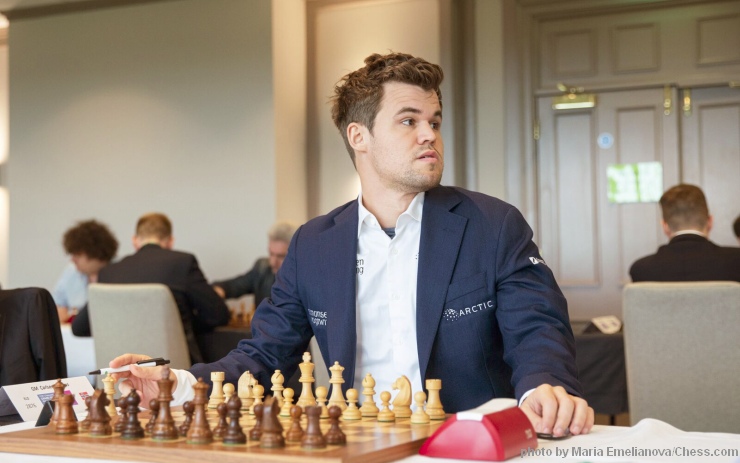
Text: Milan Dinic
Photos: Maria Emelianova/Chess.com & John Saunders
IOM International Chess Limited:
Tournament Director Alan Ormsby
masters@iominternationalchess.com
+44 7624 453200
Chess.com:
Director of Esports and Events Nick Barton
nick@chess.com
+1 8326223010
FIDE:
Chief Communications Officer David Llada
press@fide.com
+34 680312625








